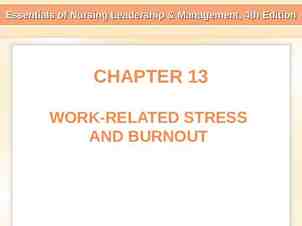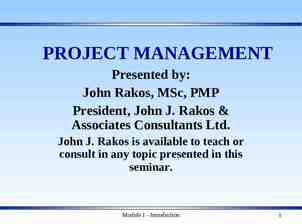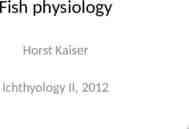Emerging and ReEmerging Infections Introduction to Infectious
42 Slides215.50 KB

Emerging and ReEmerging Infections Introduction to Infectious Outbreak Reporting and Containment Larissa May, M.D. Department of Emergency Medicine The George Washington University School of Medicine

Clinical Case 28 year old previously healthy female biologist presents with fever and spreading rash Two days ago she developed a fever, sore throat, and vomiting She has had several very dark bowel movements Today her boyfriend noted she was drowsy and disoriented She returned from Uganda 3 days ago, where she was collecting samples from wild monkeys for DNA analysis

Clinical Case Vitals: 84/52 HR 132 T 104.4 94% RA diaphoretic Tachypneic with bilateral bibasilar rales Centripetal maculopapular rash with hemorrhagic erythema on the palms and soles Subconjunctival hemorrhages, palatal petechiae Diffuse abdominal tenderness with guarding; black stool

You are the only physician working in the Emergency Department The nurse notifies you that you have two urgent incoming calls EMS is transporting a 44 year-old diplomat with massive GI and gingival bleeding, febrile to 102, blood pressure of 60/palp On the other line a concerned internist is sending two returned travelers with fever and rash

Objectives How do we recognize potential sentinel cases for an outbreak? How do we report a suspected outbreak? What measures can we take toward outbreak containment in the emergency department? What resources are available in the event of an outbreak?

Workshop ED physician Local health department National health office (CDC) Hospital administration (Incident command) Infection control officer Laboratory

Objectives How do we recognize potential sentinel cases for an outbreak? How do we report a suspected outbreak? What measures can we take toward outbreak containment in the emergency department? What resources are available in the event of an outbreak?

Why teach outbreak recognition and containment? Factors favoring the emergence of infections: (1992 IOM report) Change in physical environment Human behavorial activities Social/political/economic factors Bioterrorism Increased use of antimicrobials and pesticides 1. Centers for Disease Control and Prevention. Preventing Emerging Infectious Diseases. A Strategy for the 21 st century. 2. Global Emerging Crisis in Infectious Diseases. Challenges for the 21 st century. The Pfizer Journal. V(2), 2004.

Bioterrorism 1997: biodefense budget 137 million 2000: 1.5 billion for military biodefense and 1 billion for domestic preparedness Operation Bioshield: 6 billion over 10 years for vaccines and treatments against potential bioterrorism agents David R. Franz and Russ Zajtchuk. Bioterrorism: Understanding the threat, preparation and medical response. Disease-A-Month 48(8), August 2002.

Outbreak recognition Most outbreaks present as “flu-like illness” Size of an outbreak related to Virulence modes of transmission extent/mode of dissemination mes W. Buehler et. Al. Syndromic Surveillance and Bioterrorism-related epidemics. Emerging Infectious Diseases, Octob

Outbreak recognition Severe Gastroenteritis Fatal pneumonia in healthy patient Widened mediastinum with fever Rash with synchronous vesicular/pustular lesions Acute neurologic illness with fever Advancing cranial nerve palsy with weakness mes W. Buehler et. Al. Syndromic Surveillance and Bioterrorism-related epidemics. Emerging Infectious Diseases, Octob

Outbreak Detection: Epidemiologic Criteria Severe disease in a healthy patient Increased number of patients with fever, rash, respiratory or GI symptoms, or sepsis Large number of rapidly fatal respiratory cases Rega. Bioterrorism: A statistical manual to identify and treat diseases of bioterrorism. Mascap Inc, Ohio, 2000.

Outbreak Detection: Epidemiologic Criteria Increasing number of ill or dead animals Rapid rise and fall in the epidemic curve Multiple patients presenting from a similar location Endemic disease at an unusual time of the year Rega. Bioterrorism: A statistical manual to identify and treat diseases of bioterrorism. Mascap Inc, Ohio, 2000.

Syndromic Surveillance: Clinician’s Role 1. Healthy People 2010 initiative calls for improved surveillance systems Syndromic Surveillance: Collection and analysis of statistical data on health trends Clinicians essential for active syndromic surveillance and reporting to public health officials Determination of “credible risk” Information technology Michael Stoto et. Al. The RAND Center for Domestic and International Health Security. Syndromic Surveillance: Is it worth the effort? Chance 17(1), 2004, 19-24. 2. Peter Katona. Bioterrorism Preparedness: A generic blueprint for health

Model for Outbreak Epidemiology Susceptible Exposed Infective Removed Vaccinated KE Nelson. Infectious Disease Epidemiology: Theory and Practice. Aspen Publishers, 2001, p. 119-69.

Who do I report an Outbreak to? Call your local health department first for advice 2. Department of health 24 hour hotline Check website Local DOH will contact the Centers for Disease Control and Prevention if necessary International reporting mechanisms exist to detect emerging infections as they occur in their areas of origin Global Emerging Crisis in Infectious Diseases. Challenges for the 21 st century. The Pfizer Journal. V(2), 2004.

Outbreak Containment in the Emergency Department Detection of sentinel case Activation of the Hospital Emergency Management Plan leads to notification of Administration, Nursing, Clinical Departments, Radiology, Supplies, and other departments Notification of Infectious Disease and Infection Control 1.Peter Katona. Bioterrorism Preparedness: A generic blueprint for health departments, Hospitals and physicians. Infectious Diseases in Clinical Practice 11(3), 2004, March/April 2002. 2. Lynn K. Flowers et. Al. Bioterrorism Preparedness II: The Community and EMS Systems. Emergency Medicine Clinics of North America 20(2), May 2002.

Outbreak Containment in the Emergency Department Inform local Department of Health Epidemiologic surveillance and investigation Inform Director of Laboratory Rapid agent detection and confirmation Lab specimen handling, testing and referral Need for outside assistance Establishment of a communication system: Katona. Bioterrorism Preparedness: A generic blueprint for health departments, Hospitals and physicians. I s Diseases in Clinical Practice 11(3), 2004, March/April 2002. K. Flowers et. Al. Bioterrorism Preparedness II: The Community and EMS Systems. Emergency Medicine Clinics of North America 20(2), May 200

Outbreak Containment in the Emergency Department Isolation and environmental controls Geographical cohorting Patient and healthcare worker cohorting Admission and expedient discharge of non-infectious patients 1.Peter Katona. Bioterrorism Preparedness: A generic blueprint for health departments, Hospitals and physicians. Infectious Diseases in Clinical Practice 11(3), 2004, March/April 2002. 2. Lynn K. Flowers et. Al. Bioterrorism Preparedness II: The Community and EMS Systems. Emergency Medicine Clinics of North America 20(2), May 2002.

Outbreak Containment in the Emergency Department Patient and staff prophylaxis: responsibility of Infection Control and DOH Mass patient care: requires preidentification of surge capacity sites Staffing needs: back up/functional units Community and mental health needs: involve social work and psychiatry 1.Peter Katona. Bioterrorism Preparedness: A generic blueprint for health departments, Hospitals and physicians. Infectious Diseases in Clinical Practice 11(3), 2004, March/April 2002. 2. Lynn K. Flowers et. Al. Bioterrorism Preparedness II: The Community and EMS Systems. Emergency Medicine Clinics of North America 20(2), May 2002.

Hospital Emergency Incident Command System (HEICS) Incorporate bioterrorism/contagious outbreak plan into existing internal operations in an “all hazards” approach Incident Command Structure: Incident Commander Sub-chiefs: logistics, operations, finance, planning Common organizational structure to coordinate response to mass casualty event Peter T. Pons and Stephen V. Catrill. Mass Casualty Management: A Coordinated Response. Critical Decisions in Emergency Medicine, November 2003.

Hospital Response Plans CDC Bioterrorism Readiness Plan: A Template for Healthcare Facilities Syndrome-based criteria Infection Control Isolation precautions Patient placement Patient Transport Cleaning, disinfection, sterilization Discharge Management Post-mortem care Post-exposure management Triage of large scale exposures and suspected exposures Psychological aspects and counseling Centers for Disease Control and Prevention. APIC Bioterrorism Task Force. CDC Hospital Infections program bioterrorism working

Hospital Response Plans Activation/Notification: Administration, media relations, infection control Facility Protection: security, external triage Decontamination: self-decontamination Supplies/logistics: pharmaceuticals, PPE, ventilators Alternative care sites: Expedient discharge of patients Cancellation of elective cases Carl Shulz et. Al. Bioterrorism Preparedness I: The Emergency Department and Hospital. Emergency Medicine Clinics of North America

Hospital Response Plans Staff education/training: Mass casualty protocols and drills Coordination and communication: EMS and Fire Department Police Government Media Carl Shulz et. Al. Bioterrorism Preparedness I: The Emergency Department and Hospital. Emergency Medicine Clinics of North America 20(2), May 2002.

Outbreak Containment: State and Federal Response Local and State response DHHS identifies and applies containment for epidemics FEMA coordinates federal assistance NDMS (National Medical Disaster system) DMAT (Disaster Medical Assistance Teams) CDC: epidemiologic and laboratory expertise, control measures and prophylaxis Strategic National Stockpile Jerry L. Mothershead et. Al. Bioterrorism Preparedness III: State and Federal and Response. America 20(2), May 2002. Emergency Medicine Clinics of North

Resources During an Outbreak CDC Bioterrorism Website www.bt.cdc.gov Johns Hopkins Center for Civilian Biodefense Studies www.hopkins-defense.org US Army Medical Research Institute for Infectious Diseases www.usamriid.army.mil

HICPAC Infection Control Guidelines Established by CDC in 1991 Standard precautions: exposure to blood and body fluids. Personal protective equipment (PPE): gown, gloves, mask with eye protection Contact isolation: PPE for all healthcare worker interactions, private room, dedicated patient equipment, limit transport http://www.cdc.gov/ncidod/hip/HICPAC/publications.htm

HICPAC Infection Control Guidelines Droplet: for microbes less than 5 micrometers in diameter, transmissible at less than 3 feet distance. PPE including mask at all times Airborne: small infectious particles. PPE including N95/PAPR, negative pressure isolation room with 6-12 air changes per hour http://www.cdc.gov/ncidod/hip/HICPAC/publications.htm

EBOLA What could have been done? 1995 Ebola outbreak in Congo: 240 deaths in 4 months Delayed outbreak reporting Hospital-promoted transmission Provision of disinfectant and PPE led to containment 1997 Ebola outbreak in the Congo: 19 days to outbreak awareness 49 days to international assistance Centers for Disease Control and Prevention. Preventing Emerging Infectious Diseases. A Strategy for the 21 st century.

Lessons from SARS Outbreak cost estimated at 80 billion Efficient response by GOARN, GPHIN and Promed mail Ontario provincial emergency: creation of SARS units Singapore: 10 day quarantine for all SARS contacts, screening of all airport and seaport arrivals for fever Joshua Lederberg et. Al. Emerging Infections: Microbial threats to health in the United Sates. Institute of Medicine, 1992.

Lessons from SARS: Containment Infected patients: Detection Isolation Containment Uninfected patients Monitoring protection Conversion of patient rooms into isolation rooms “hotwards” Designated ambulance service Back up teams/functional units Lessons Learned from SARS: Management of an Emerging Infectious Disease from a Military Perspective.

Emerging Infections: A Deadly Prospect “When Veronica brought him back to the same clinic, he was running a fever of 103 degrees F, His systolic blood pressure was low .Although Veronica was panicked, she tried to bear in mind what Azikiwe had told her. American doctors weren’t like they were in Nigeria.they knew what they were doing Now, after three visits to the HMO, she wasn’t so sure Still, no one asked him about travel.” From Level 4: Virus Hunters of the CDC. By Joseph B. McCormick and Susan Fisher-Hoch with Leslie Anne Horvitz. Barnes and Noble Books: New York, New York, 1996.

Clinical Case (continued) A tentative diagnosis of viral hemorrhagic fever is made Patients placed in airborne isolation, cohorted with staff You call Infectious Disease on Call and Hospital Administration for activation of the Contagious Disease Outbreak Plan You notify the DC DOH emergency hotline and the CDC for recommendations and assistance in containment of the outbreak and contact tracing Identification and confirmation of Ebola serotype made by USAMRIID BSL 4 laboratory

Viral Hemorrhagic Fever: Filoviruses Marburg and Ebola cause severe illness Family endemic to Central Africa Marburg first identified in Germany in 1967 in lab-workers exposed to infected monkeys Ebola-Reston virus discovered in 1989 in imported monkeys Multiple outbreaks since 1977 Ebola Zaire 88% mortality Long period of infectivity Body fluids of deceased infectious Omar Lupi and Stephen K. Tyring. Tropical Dermatology: viral tropical Diseases. Journal of the American Academy of Dermatology 49 (6),

Viral Hemorrhagic Fever: Filoviruses Incubation period 4-5 days Sudden onset high fever, sore throat, fatigue, headache Nonpruritic maculopapular centripetal rash desquamates after one week GI, skin and mucous membrane hemorrhages Omar Lupi and Stephen K.Tyring. Tropical Dermatology: viral tropical Diseases. Journal of the American Academy of Dermatology 49

Viral Hemorrhagic Fever: Filoviruses Leukopenia, thrombocytopenia, transaminitis Mortality from hemorrhage and hypovolemic shock Differential Diagnosis: Yellow fever, dengue, meningococcemia, leptospirosis, ITP Omar Lupi and Stephen K.Tyring. Tropical Dermatology: viral tropical Diseases. Journal of the American Academy of Dermatology 49

Viral Hemorrhagic Fever: Filoviruses Diagnosis Immunofluorescence or ELISA PCR Therapy Supportive No vaccine yet available Omar Lupi and Stephen K.Tyring. Tropical Dermatology: viral tropical Diseases. Journal of the American Academy of Dermatology 49

Guidelines Contact isolation Cannot rule out airborne transmission PAPR provides better filtration than N95 but more expensive and increases needlestick risk Supportive treatment Experimental IND for ribavirin in arenaviruses Luciana Borio et. Al. Hemorrhagic Fever Viruses as Biological Weapons: Medical and Public Health Management. JAMA 287(18), May 8,

Outbreak Preparedness: Goals for Clinicians Be familiar with epidemiologic criteria for sentinel cases Know your hospital emergency preparedness plans and how to report a suspected sentinel case Follow basic principles of isolation, infection control, and cohorting in an outbreak

References David R. Franz and Russ Zajtchuk. Bioterrorism: Understanding the threat, Preparation and medical response. Disease-A-Month 48(8), August 2002. 2. Rega. Bioterrorism: A statistical manual to identify and treat diseases of bioterrorism. Mascap Inc, Ohio, 2000. 3. Michael Stoto et. Al. The RAND Center for Domestic and International Health Securtiy. Syndromic Surveillance: Is it worth the effort? Chance 17(1), 2004, 19-24. 4. Ben Y. Reise and Kenneth D. Mandl. Syndromic Surveillance: the effects of syndrome grouping on model accuracy and outbreak detection. Annals of Emergency Medicine 44(3(), September 2004. 5. James W. Buehler et. Al. Syndromic Surveillance and Bioterrorism-related epidemics. Emerging Infectious Diseases, October 2003 6. Edward N. Barthell et. al. Syndromic Surveillance: The Frontiers of Medicine project: a roposal for the standardization communication of ED data for public health uses including syndromic Surveillance. Annals of Emergency Medicine 39(4), April 2002. 7. Peter Katona. Bioterrorism Preparedness: A generic blueprint for health departments, Hospitals and physicians. Infectious Diseases in Clinical Practice 11(3), 2004,March/April 2002. 8.Seth Foldy et. Al. Syndromic Surveillance Using Regional Emergency Medicine Internet. Annals of Emergency Medicine 44(3), September 2004. 9.The George Washington University Contagious Disease Outbreak Plan. January 2005. 1.

References 10. Fred M. Burkles, Jr. Mass Casualty Management of a Large Scale Bioterrorism Event: An Epidemiologic Approach that Shapes Triage Decisions. Emergency Clinics of North America 20(2), May 2002. 11.KE Nelson. Infectious Disease Epidemiology: Theory and Practice. Aspen Publishers, 2001, p. 119-69. 12.Centers for Disease Control and Prevention. Preventing Emerging Infectious Diseases. A Strategy for the 21st century. 13. Global Emerging Crisis in Infectious Diseases. Challenges for the 21 st century. The Pfizer Journal. V(2), 2004 14. Joshua Lederberg et. Al. Emerging Infections: Microbial threats to health in the United Sates. Institute of Medicine, 1992. 15. Lessons Learned from SARS: Management of an Emerging Infectious Disease from a Military Perspective. www.mindef.gov.sg 16. Lynn K. Flowers et. Al. Bioterrorism Preparedness II: The Community and EMS Systems. Emergency Medicine Clinics of North America 20(2), May 2002. 17. Fred M. Henretig. Medical Management of the Suspected Victim of Bioterrorism:An algorithmic approach to the undifferentiated patient. Emergency Medicine Clinics of North America 20(2), May 2002. 18. CDC Bioterrorism Website www.bt.cdc.gov 19. John Hick et. Al. Health Care Facility and Community Strategies for Patient Surge Capacity.Annals of Emergency Medicine Volume 44 Number 3 September 2004 20. Jerry L. Mothershead et. Al. Bioterrorism Preparedness III: State and Federal and Response. Emergency Medicine Clinics of North America 20(2), May 2002. 21. Centers for Disease Control and Prevention. APIC Bioterrorism Task Force. CDC Hospital Infections program bioterrorism working Group.

References 22. Peter T. Pons and Stephen V. Catrill. Mass Casualty Management: A CoordinatedResponse. Critical Decisions in Emergency Medicine, November 2003. 23. Carl Shulz et. Al. Bioterrorism Preparedness I: The Emergency Department and Hospital. Emergency Medicine Clinics of North America 20(2), May 2002. 24. www.cdc.gov/ncidod/hip/HICPAC/publications.htm 25. Luciana Borio et. Al. Hemorrhagic Fever Viruses as Biological Weapons: Medical and Public Health Management. JAMA 287(18), May 8, 2002. 27. Omar Lupi and Stephen K.Tyring. Tropical Dermatology: viral tropical Diseases. Journal of the American Academy of Dermatology 49 (6), December 2003. 28. 21st Century Bioterrorism and Germ Weapons—U.S. Army Field Manual for the Treatment of Biological Warfare Agent Casualties, 2000. 29. Robert Darling et. Al. Threats in Bioterrorism I: CDC Category A agents. Emergency Medicine Clinics of North America 20(2), May 2002. 30.The 1, 2, 3's of Biosafety Levels Jonathan Y. Richmond, Ph.D. Director, Office of Health and Safety Centers for Disease Control and Prevention Atlanta, GA 30333. Adapted from the CDC/NIH 3rd edition of Biosafety in Microbiological and Biomedical Laboratories






